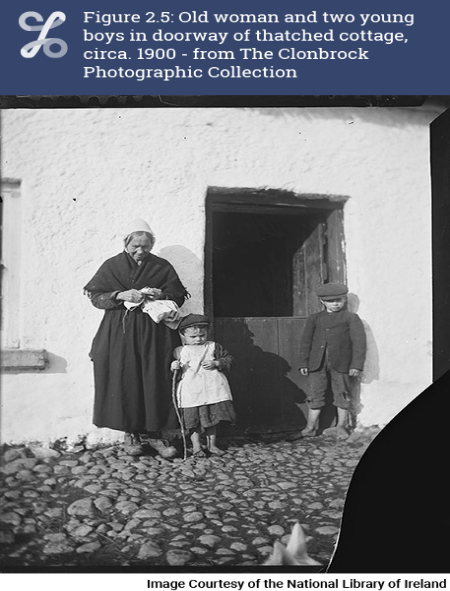The wealthiest counties were in the east of the country, while poorer counties tended to be located on the western seaboard (See Figure 2.1).
_by_county_Map-01.png)
Out of the 20 wealthiest DEDs, 17 were in Leinster. Eight of the top 20 wealthiest DEDs were in Meath, the highest number for any county. The remaining 12 DEDs in the top 20 were in Kildare (three), Queens County (two), Westmeath (two) and one each in Belfast City, Cork, Dublin City, Dublin County and Roscommon (See Table 2.2).

Out of the 20 poorest DEDs, 11 were in Connaught while there were none from Munster. Donegal had eight DEDs out of the 20 poorest DEDs, the highest amount for any county (See Table 2.3).

Culmullin DED in Meath was identified as the wealthiest DED in 1911 with a valuation per person of £20.97. Culmullin had a land area of 9,036 acres with 129 houses in 1911, of which 115 were inhabited (See Table 2.4).
Annagary DED in Donegal was identified as the poorest DED in 1911 with a valuation per person at £0.23. Annagary had a land area of 9,731 acres with 694 houses, of which 639 were inhabited (See Table 2.4).
In the Census of Ireland, 1911, the Gaisford household were recorded as living in Culmullin DED, Meath. The Gaisford household consisted of five people – a married couple (Douglas and Elizabeth Gaisford) and three servants (Sarah Browne, Fanny Ashell and Emily McIlray). Their house had 21 rooms along with 13 outhouses and farmsteadings. Douglas Gaisford is also listed as the landholder for three other houses on associated returns. The Census returns for the other three houses contain occupation descriptions such as gardener, coachman, or general labourer – presumably for persons employed by the Gaisford household.
The original Census Form A for the Gaisford household can be found here on the National Archives website.
The Form B. 1. House and Building Return contains a description of the Gaisford’s property (house 1) and can be found here on the National Archives website.

In the Census of Ireland, 1911, the Duffy household were recorded as living in Annagary DED, Donegal. The Duffy household consisted of 11 people with the head of family, Grace Duffy, listed as a farmer’s wife. There were nine children aged from 18 down to one year old and a grandmother aged 73. Their house contained just two rooms along with one outhouse or farmsteading. This household Census return records the roof of this house as being of ‘Thatch, wood or other perishable material’ while the walls were of ‘stone, brick or concrete’.
The original Census Form A for the Duffy household can be found here on the National Archives website.
The Form B. 1. House and Building Return contains a description of the Duffy’s property (house 23) and can be found here on the National Archives website.

Learn about our data and confidentiality safeguards, and the steps we take to produce statistics that can be trusted by all.